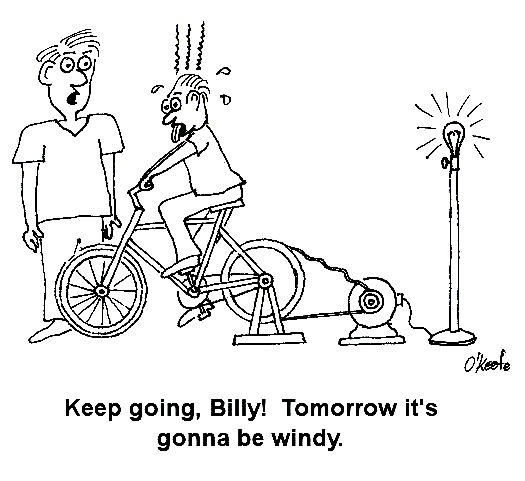|
This week’s blog is a re–publication of a web article by Alex Salkever which appeared on April 6, 2010, in Daily Finance, an AOL Money and Finance site. It’s an excellent followup to last week’s blog on wind turbine energy, which raised concerns as to the feasibility of its widespread use. It’s always good to have multiple sources of information when assessing the value of anything, such as when you seek a doctor’s second opinion, and this article serves that purpose. Enjoy! Too Green, Too Soon? Renewable Power May Destabilize Electrical Grid By Alex Salkever Boy, that was fast. Only five years into the world’s renewable energy push, many utility companies are so concerned about grid instability that they’re saying they can’t accept any more electricity from intermittent sources of power. Translation: Solar power only runs in the day time and can’t re relied on for so called “baseload” capacity. Wind power primarily produces current at night and, likewise, can’t be relied upon for baseload capacity. Geothermal, meanwhile, is perfect for providing baseload. But geothermal projects take an excruciatingly long time to build out. And then there have been the recent spate of earthquake scares around geothermal sites. The upshot: Utilities such as Hawaiian Electric in President Obama’s home state are voicing concerns about plans to integrate more solar and wind power into the grid until they develop methods to more effectively absorb intermittent sources of power without destabilizing the whole shebang. In Europe, Czech utility companies are concerned that “feed-in tariffs,” which require power companies to repurchase all home- and business-generated renewable power at elevated rates, might wreak havoc on the Central European grid. This growing push-back from utilities could prove to be shock to energy project developers, lawmakers and homeowners. In the U.S., project developers and state lawmakers have assumed that the ambitious laws mandating as much as 40% of some states’ power come from renewable sources within the next few decades would ensure huge demand for green power as utilities scaled up their use of such resources from low single-digit levels. Likewise, homeowners have tended to assume that if they could put a panel on their roof (or a windmill on their property), they would be guaranteed a market for the extra power produced. Storing Excess Power in Ice, Salt or Even … Caves? The ability to sell back power to a utility at retail rates (meaning the rates they charge the public) is dubbed “net metering,” and many states have limitations on what percentage of total baseload power on a grid a utility must buy back. It was broadly assumed net metering would go away in hurry when the Green Revolution came of age. Now, that appears unlikely. The alleged problems with absorbing intermittent green power point to a more fundamental issue with the existing power grid — namely, that the system isn’t really ready to handle a significantly more distributed power production footprint. One possible remedy would be for utilities to build more power storage systems, and many new forms for those are on the drawing boards. One solution could be massive battery installations from the likes of A123 Systems. Another could be a system such as that offered by Ice Energy, which uses cheap power at night to make ice, reducing the power requirements of air conditioning systems in the daytime. This effectively arbitrages the price differential between nighttime and daytime power generation — something that potentially could be a huge boon for wind power. Other, more exotic “battery” systems that have been proposed include storing power in molten salt or injecting compressed air into sealed caves, both of which create potential energy that can later be used to power electric generators. Power storage is already being recognized as essential to new renewable energy projects. A wind farm on Maui will be the first in the country to have an added power storage component in the form of a bank of lithium-ion batteries. But most green power developers are still having trouble competing with coal and natural gas fired plants on a level playing field — even without adding in the costs of power storage. If the issues of dealing with intermittent power sources are as disruptive to grid stability as some traditional utilities are claiming, the Green Revolution may be a case of “too much, too soon” — at least until the engineers can figure out better, cheaper ways to capture sunshine and wind in a bottle. From DailyFinance: http://srph.it/dAoxAj _________________________________________________________________ |
Engineering Expert Witness Blog
Published by Philip J. O'Keefe, PE, MLE




